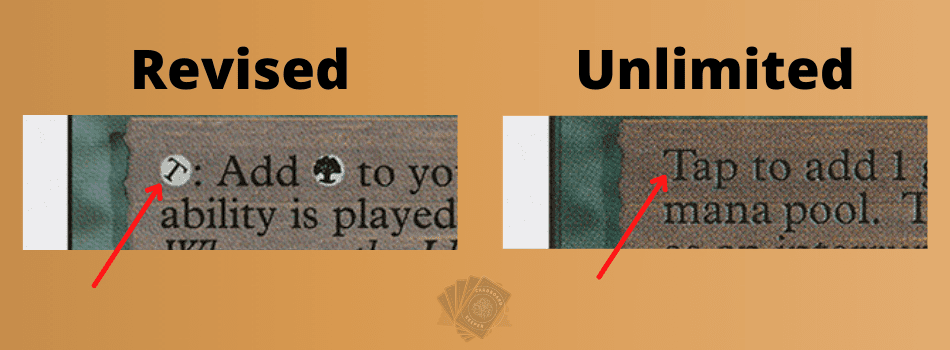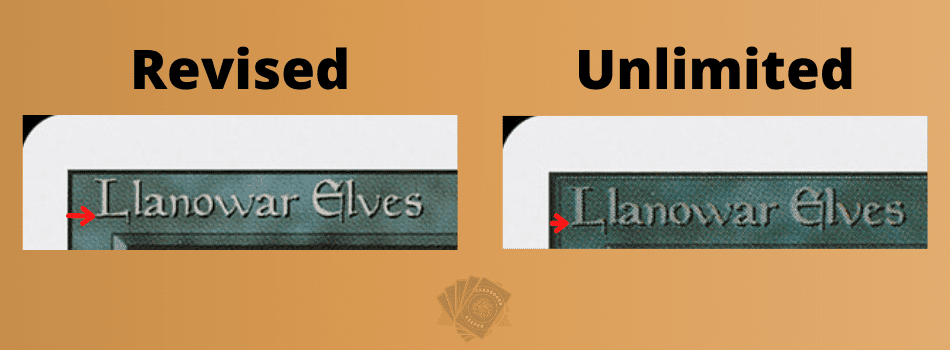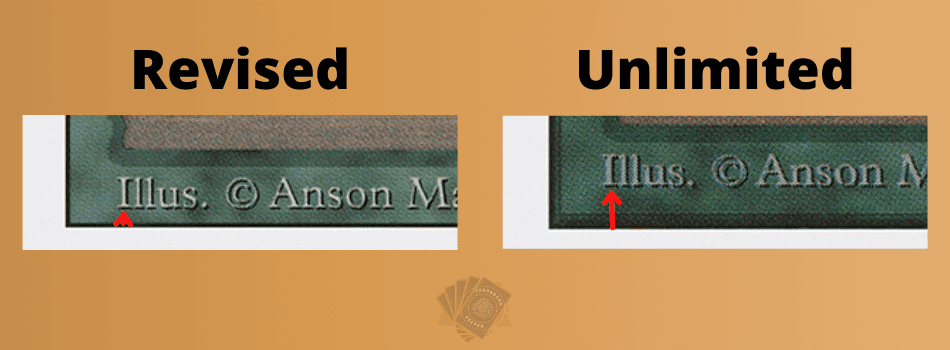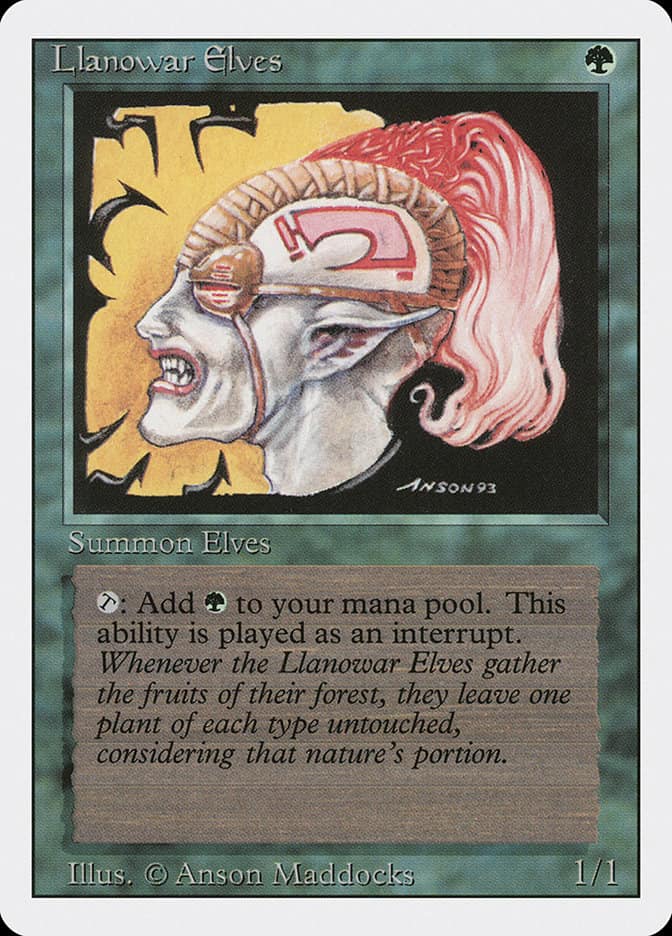In order to be able to tell the difference between whether a card you have is from the Unlimited or Revised sets, you first want to make sure that those 2 sets are actually your only 2 options.
The Unlimited and Revised share a combination of similarities that are only found in those Magic sets. Here are some of the important physical qualities that both Unlimited and Revised share.
Unlimited vs Revised MTG Comparison Table
| Feature | Unlimited | Revised |
|---|---|---|
| White Border | ✔ | ✔ |
| Light Colors | ✔ | |
| Dark Colors | ✔ | |
| Only English Text | ✔ | |
| No Copyright Symbol | ✔ | ✔ |
| Artist Name Centered | ✔ | ✔ |
| Card Name to the Left | ✔ | |
| Tap Symbol | ✔ | |
| Mana Symbols in Textbox | ✔ |
White Border
All Unlimited and Revised cards are white-bordered.
However, just because your card has a white border doesn’t automatically make it Unlimited or Revised.
The following set in Magic The Gathering also has white borders:
- Fourth Edition
- Fifth Edition
- Sixth Edition
- Seventh Edition
- Eighth Edition
- Ninth Edition


Lighter and Darker Colors
A very common way of telling the difference between an Unlimited and Revised version of a card is to compare how dark or bright the colors of the card are.
Even when we look at a card like Serra Angel, which is relevantly a bright card with art and color being associated with white, there is still quite a contrast between the colors on the card.
As a general rule, the Unlimited version of an MTG card will have darker art and coloring compared to a Revised version of the same card. This difference in color and contrast can be seen to a greater effect in cards that use dark colors in their artwork.
English Text
The Unlimited unlimited set was only printed in English. It would be sometime later that Magic would grow in popularity and between 1995-98 Magic cards would become available in over a dozen languages. (Source)
The majority of the Revised set was printed in English and you are far more likely to run into the English versions of this set. However, some number of the Revised set was printed in a few other languages later in 1994, the year of Revised’s original English printing. (Source)
Here is a list of other languages that the Revised set was printed in:
- French
- German
- Italian
No Wizards of The Coast Copyright Symbol
Both the Unlimited and Revised sets of cards do not have the Wizards of the Coast’s copyright line of text printed on them.
“2015 Wizards of the Coast, Inc. All Rights Reserved”
You’ll find this line of copyright text on most newer sets of Magic and so this can be a good way of determining what period of Magic’s history a card was printed in.

The Tap Symbol
In Alpha, cards with a tap ability simply said “Tap THIS CARD to _,” without the need for additional markings.
The most significant tool for Magic templating was introduced in Revised. The colon did a fantastic job with regards to defining what was considered the cost of an ability from the ability’s effect.
Tapping became a part of the cost after Revised was introduced. As a result, it had to come before the colon. However, spelling it out was wordy and added to the issue of cards having walls of text on them for players to read.
When the tap symbol was introduced, many Magic players voiced their concerns about the change.
Fast forward over 10 years, and the tap symbol has now become one of the most recognized symbols in the game of Magic The Gathering.
Because the tap symbol was introduced in Revised, if you are inspecting a card and you’re uncertain about whether it might be from the Unlimited set, check to see if it has the tap symbol on it for any activated abilities.
If you find a tap symbol, then you know it is not from the Unlimited set. (Source)

Card Name / Title and Border
You have to pay a little bit of attention to this one, but it’s not too hard to spot when you know what you are looking for.
Revised cards have the name of the card further away from the black border of cards.
In Contrast, Unlimited cards have the name of the card sitting much closer to the black outline/board of the Magic card.

Artist Name Location – Baseline Distance
Probably my favorite way to be able to tell the difference between an Unlimited and Revised card is the location of the artist’s name on the card.
If you measure from the inner black border of a card, you can see there is a substantial difference between the distance of the black line and the artist’s name.
Revised cards tend to sit on top of the black line/border at the bottom of the card.
Unlimited cards will sit more in the middle of the space that sits between the black line and the card’s text.
Honestly, if you take one thing away from this post, it should be this. It is incredibly easy and fast to spot this difference, so if you are going to rely on one method to tell help you identify which set these cards are from I strongly recommend this one.


Changing Mana Color Words to Mana Symbols
In Alpha, Llanowar elves read “Tap to add 1 green mana to your mana pool. This tap can be played as an interrupt.”
Not only was the “Tap to” wording changed to a tap symbol, but the “1 green mana.” line of text had the “green mana” changed to a green mana symbol. Some players, for whatever reason, were dissatisfied with the mana symbols being used in the text box. However, just like the tap symbol, it was a change for the better.
Because the change to using mana symbols from words took place when the Revised set was released, cards that have the mana symbol in their text boxes are not from Unlimited.
If you find a mana symbol in your card’s text box, then you can feel pretty confident that the card was printed in or after the Revised set.

